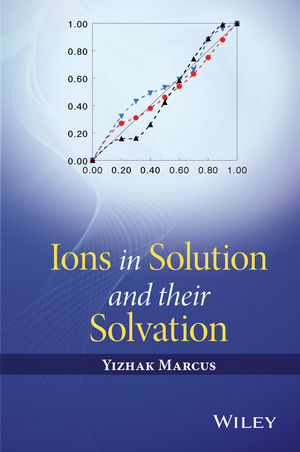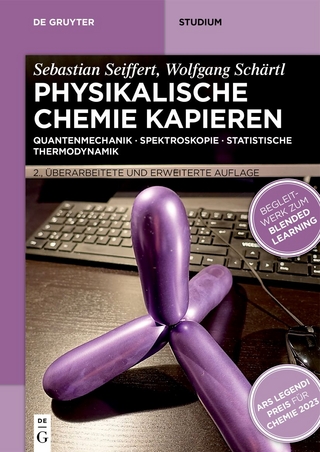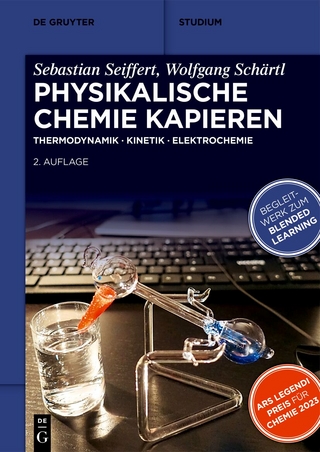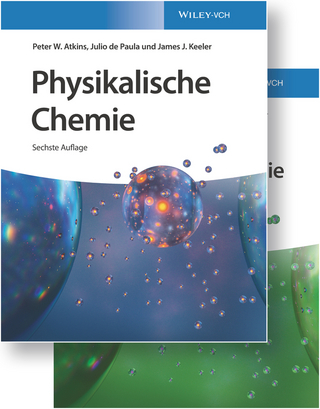
Ions in Solution and their Solvation
John Wiley & Sons Inc (Verlag)
978-1-118-88914-5 (ISBN)
the relevant properties of prospective liquid solvents for the ions
the process of the transfer of ions from the gas phase into a liquid where they are solvated
various aspects of the solutions of the ions, such as structural and transport ones and the effects of the ions on the solvent dynamics and structure
what happens in cases where the solvent is a mixture selective solvation takes place
applications of the concepts expounded previously in fields such as electrochemistry, hydrometallurgy, separation chemistry, biophysics, and synthetic methods
Yizhak Marcus, PhD, is Professor Emeritus at the Hebrew University in Jerusalem. He was a researcher at the Soreq Nuclear Research Center, from where he was appointed in 1965 as Professor of Inorganic and Analytical Chemistry at the Hebrew University until his retirement in 1999. His main interest is the chemistry of liquids and solutions: aqueous, non-aqueous, and mixed solvents, solutions of electrolytes and non-electrolytes. He has published eight books and over 300 papers in refereed journals as well as roughly 30 contributions in multi-author books.
Preface ix
1 Introduction 1
1.1 The Significance and Phenomenology of Ions in Solution 1
1.2 List of Symbols and Abbreviations 5
2 Ions and Their Properties 10
2.1 Ions as Isolated Particles 10
2.1.1 Bare Ions 11
2.1.2 Ions in Clusters 26
2.2 Sizes of Ions 30
2.3 Ions in Solution 35
2.3.1 Thermodynamics of Ions in Aqueous Solutions 38
2.3.1.1 Heat Capacities of Aqueous Ions 38
2.3.1.2 Entropies of Aqueous Ions 39
2.3.1.3 Enthalpies of Formation of Aqueous Ions 43
2.3.1.4 Gibbs Energies of Formation of Aqueous Ions 44
2.3.1.5 Ionic Molar Volumes in Aqueous Solutions 44
2.3.2 Other Properties of Aqueous Ions 49
2.3.2.1 Ionic Conductivities in Aqueous Solutions 49
2.3.2.2 Ionic Self]Diffusion in Aqueous Solutions 50
2.3.2.3 Ionic Effects on the Viscosity 51
2.3.2.4 Ionic Effects on the Relaxation of NMR Signals 55
2.3.2.5 Ionic Dielectric Decrements 55
2.3.2.6 Ionic Effects on the Surface Tension 56
References 58
3 Solvents for Ions 63
3.1 Solvent Properties that Suit Ion Dissolution 63
3.2 Physical Properties of Solvents 64
3.2.1 Volumetric Properties 64
3.2.2 Thermodynamic Properties 69
3.2.3 Electrical, Optical, and Magnetic Properties 70
3.2.4 Transport Properties 75
3.3 Chemical Properties of Solvents 77
3.3.1 Structuredness 77
3.3.2 Solvent Properties Related to their Ion Solvating Ability 80
3.3.2.1 Polarity 81
3.3.2.2 Electron Pair Donicity and Ability to Accept a Hydrogen Bond 83
3.3.2.3 Hydrogen Bond Donicity and Electron Pair Acceptance 84
3.3.2.4 Softness 85
3.3.3 Solvents as Acids and Bases 86
3.3.4 Miscibility with and Solubility in Water 88
3.3.5 Spectroscopic and Electrochemical Windows 90
3.4 Properties of Binary Aqueous Cosolvent Mixtures 90
3.4.1 Physical Properties of Binary Aqueous Mixtures with Cosolvents 90
3.4.1.1 Thermodynamic Properties of the Mixtures 92
3.4.1.2 Some Electrical, Optical, and Transport Properties of the Mixtures 98
3.4.2 Chemical Properties of Binary Aqueous Mixtures with Cosolvents 98
3.4.2.1 Structuredness 98
3.4.2.2 Properties Related to the Ion Solvating Ability 101
References 104
4 Ion Solvation in Neat Solvents 107
4.1 The Solvation Process 107
4.2 Thermodynamics of Ion Hydration 109
4.2.1 Gibbs Energies of Ion Hydration 109
4.2.1.1 Accommodation of the Ion in a Cavity 110
4.2.1.2 Electrostatic Interactions 110
4.2.2 Entropies of Ion Hydration 116
4.2.3 Enthalpies of Ion Hydration 116
4.3 Transfer Thermodynamics into Nonaqueous Solvents 117
4.3.1 Selection of an Extra]Thermodynamic Assumption 117
4.3.2 Thermodynamics of Transfer of Ions into Nonaqueous Solvents 118
4.3.2.1 Gibbs Energies of Transfer 118
4.3.2.2 Enthalpies of Transfer 126
4.3.2.3 Entropies of Transfer 130
4.3.2.4 Ionic Heat Capacities in Nonaqueous Solvents 130
4.3.2.5 Ionic Volumes in Nonaqueous Solvents 133
4.4 The Structure of Solvated Ions 135
4.4.1 Hydration Numbers from Diffraction Studies 138
4.4.2 Hydration Numbers from Computer Simulations 139
4.4.3 Hydration Numbers from Bulk Properties 141
4.4.4 Solvation Numbers in Nonaqueous Solvents 147
4.5 The Dynamics of Solvated Ions 147
4.5.1 The Mobility of Ions in Solution 147
4.5.2 Rate of Solvent Exchange Near Ions 150
4.6 Acid/Base Properties of Ions in Solution 151
References 153
5 Mutual Effects of Ions and Solvents 156
5.1 Ion Effects on the Structure of Solvents 156
5.1.1 Experimental Studies of Ion Effects on the Structure of Solvents 156
5.1.1.1 Self]diffusion of Water Molecules 156
5.1.1.2 Viscosity B]Coefficients 157
5.1.1.3 NMR Signal Relaxation 159
5.1.1.4 Dielectric Relaxation 159
5.1.1.5 Vibrational Spectroscopy 160
5.1.1.6 X]Ray Absorption and Scattering 162
5.1.1.7 Structural Entropy 163
5.1.1.8 Transfer from Light to Heavy Water 165
5.1.1.9 Internal Pressure 168
5.1.1.10 Some Other Experimental Results 170
5.1.2 Computer Simulations of Ion Effects on the Structure of Solvents 170
5.2 Ion Effects on the Dynamics of the Solvent 171
5.2.1 Mean Residence Times of Solvent Molecules Near Ions 171
5.2.2 Experimental Studies of Ion Effects on the Solvent Orientation Dynamics 174
5.2.2.1 Ultrafast Infrared Spectroscopy 174
5.2.2.2 High]frequency Dielectric Relaxation Spectroscopy 176
5.2.2.3 NMR Relaxation Times 178
5.2.3 Computer Simulations of Reorientation Times 180
5.3 Solvent Effects on the Properties of Ions in Solution 180
5.3.1 Bulk Properties 180
5.3.2 Molecular Properties 186
References 187
6 Ions in Mixed Solvents 193
6.1 Ion Transfer into Solvent Mixtures 194
6.2 Properties of Ions in Solvent Mixtures 199
6.2.1 Thermodynamic Properties of Ions in Mixed Solvents 199
6.2.2 Transport Properties of Ions in Mixed Solvents 203
6.3 Preferential Solvation of Ions 205
6.3.1 Spectroscopic Studies 207
6.3.2 Results from Thermodynamic Data 210
6.3.2.1 The QLQC Method 211
6.3.2.2 The IKBI Method 213
6.3.2.3 Treatments Based on Stepwise Solvent Replacements 215
References 216
7 Interactions of Ions with Other Solutes 219
7.1 Ion–Ion Interactions 219
7.1.1 Activity Coefficients of Electrolyte Solutions 220
7.1.2 Ion Hydration Related to Ion–Ion Interactions 223
7.2 Ion Association 227
7.2.1 Electrostatic Theory of Ion Association 230
7.2.1.1 Activity Coefficients of Neutral Ion Pairs 231
7.2.2 Methods for Studying Ion Association 232
7.2.3 Thermodynamic Quantities Pertaining to Ion Association 234
7.2.4 Aggregation of Ions in Solutions 237
7.3 Salting]in and Salting]out 239
7.3.1 Empirical Setschenow Constant Data 240
7.3.2 Interpretation of Salting Phenomena 240
References 244
8 Applications of Solutions of Ions 247
8.1 Applications in Electrochemistry 248
8.1.1 Batteries and Supercapacitors 248
8.1.2 Solvent]Independent pH and Electrode Potential Scales 251
8.2 Applications in Hydrometallurgy 257
8.3 Applications in Separation Chemistry 259
8.3.1 Solvent Extraction of Alkali Metal Cations 259
8.3.2 Solvation of Ionizable Drug Molecules 262
8.4 Applications to Chemical Reaction Rates 264
8.5 Solvated Ions in Biophysical Chemistry 269
8.5.1 The Hofmeister Series 270
8.5.1.1 The Anion Hofmeister Series 270
8.5.1.2 The Cation Hofmeister Series 271
8.5.1.3 Interpretation of the Hofmeister series 272
8.5.2 Water Structure Effects of Ions 275
8.5.3 Some Aspects of Protein Hydration 277
References 279
Author Index 000
Subject Index 000
| Verlagsort | New York |
|---|---|
| Sprache | englisch |
| Maße | 160 x 241 mm |
| Gewicht | 558 g |
| Themenwelt | Naturwissenschaften ► Chemie ► Physikalische Chemie |
| Naturwissenschaften ► Chemie ► Technische Chemie | |
| Technik | |
| ISBN-10 | 1-118-88914-2 / 1118889142 |
| ISBN-13 | 978-1-118-88914-5 / 9781118889145 |
| Zustand | Neuware |
| Informationen gemäß Produktsicherheitsverordnung (GPSR) | |
| Haben Sie eine Frage zum Produkt? |
aus dem Bereich


